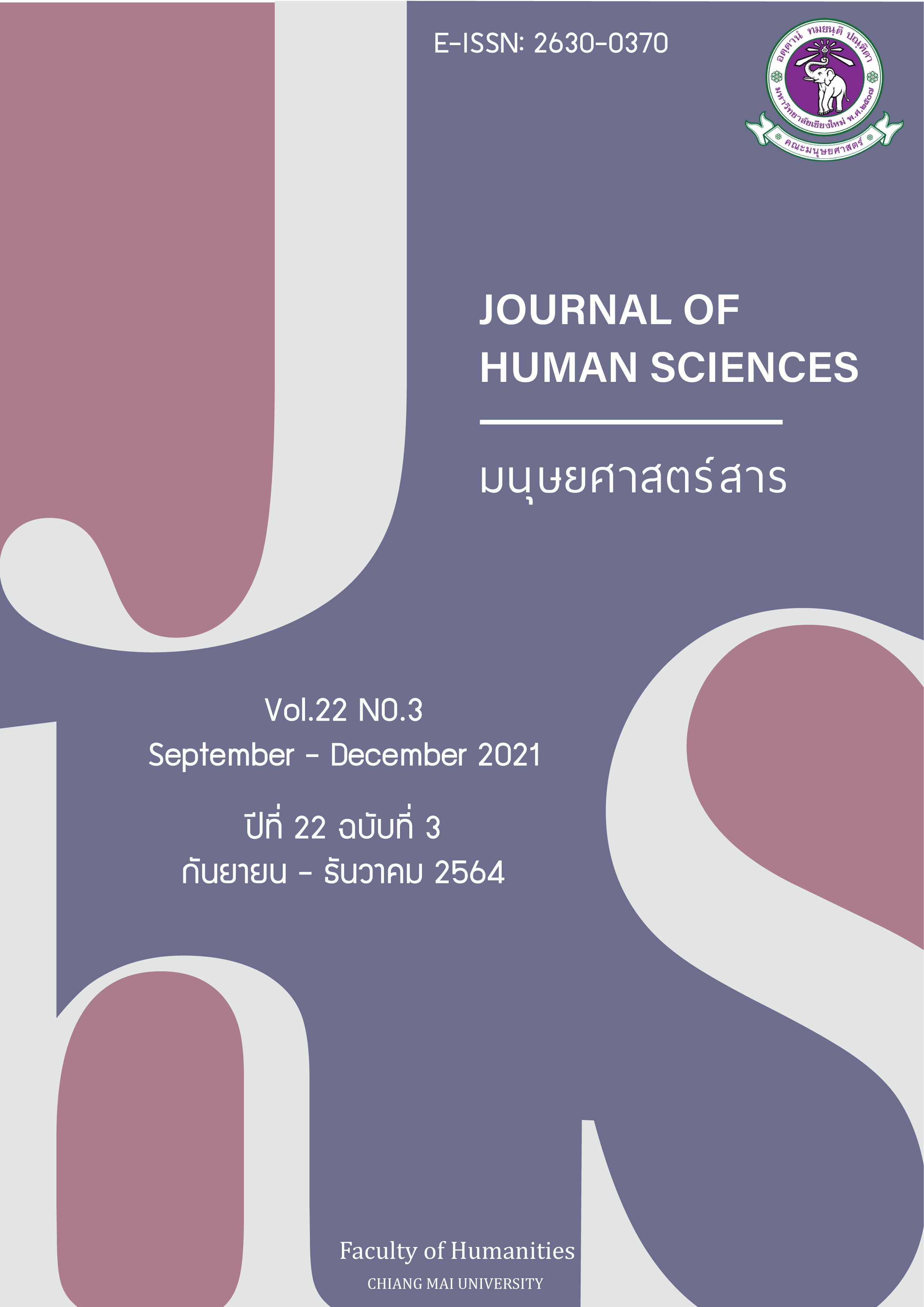การให้เหตุผลในการสนทนาโต้แย้งเป็นภาษาอังกฤษของนักศึกษาภาควิชาภาษาอังกฤษ ชั้นปีที่ 1 มหาวิทยาลัยเชียงใหม่
Main Article Content
บทคัดย่อ
สถาบันอุดมศึกษาในประเทศไทยส่งเสริมให้ผู้สอนสอดแทรกการคิดอย่างมีวิจารณญาณในชั้นเรียนรวมถึงในการเรียนการสอนวิชาภาษาอังกฤษ อย่างไรก็ตาม วรรกรรมที่เผยแพร่ความรู้ความเข้าใจเกี่ยวกับระดับทักษะการคิดอย่างมีวิจารณญาณของผู้เรียนในระดับอุดมศึกษาในประเทศไทยยังมีจำนวนน้อย บทความวิจัยนี้นำเสนอความรู้ความเข้าใจในเรื่องนี้ ผ่านการศึกษาทักษะการให้เหตุผลของนักศึกษาภาควิชาภาษาอังกฤษ ชั้นปีที่ 1 มหาวิทยาลัยเชียงใหม่ ที่สมัครใจเข้าร่วมการวิจัย จำนวน 14 คน ผู้วิจัยวิเคราะห์ข้อมูลที่ได้จากการถอดเทปบันทึกเสียงการสนทนาโต้แย้งเป็นภาษาอังกฤษของผู้เข้าร่วมการวิจัย จำนวน 21 สคริปท์ เพื่อศึกษาเหตุผลที่ไม่ถูกต้องในการสนทนาโต้แย้ง นอกจากนี้ ผู้วิจัยวิเคราะห์ข้อมูลจากการสัมภาษณ์ผู้เข้าร่วมการวิจัย จำนวน 12 คน เพื่อศึกษาสิ่งที่เป็นอุปสรรคต่อการพัฒนาทักษะการคิดอย่างมีเหตุผล จากการวิเคราะห์ข้อมูลการสนทนาโต้แย้งพบว่า ข้อโต้แย้งและเหตุผลจำนวนมากไม่ถูกต้องตามหลักของการอภิปรายโต้แย้ง สูงสุดเป็นอันดับ 1 คือ การนำผลที่เกิดขึ้นกับเหตุการณ์แรกไปขยายผลในเหตุการณ์ต่อไป ซึ่งขัดกับหลักการที่ว่า การสร้างข้อโต้แย้งต้องเป็นไปตามแบบแผนที่ถูกต้อง อันดับ 2 การนำเสนอข้อโต้แย้งในลักษณะที่ว่าข้อโต้แย้งนั้นเป็นจริงและไม่จำเป็นต้องมีการพิสูจน์ใด ๆ ซึ่งขัดกับหลักการที่ว่า ผู้อภิปรายต้องไม่ปฏิเสธที่จะป้องกันข้อโต้แย้งที่ตนเองได้นำเสนอ อันดับ 3 การสร้างข้อสรุปจากเงื่อนไขที่ไม่สมเหตุผล และการใช้คำถามนำที่สร้างจากสมมติฐานของตน การให้เหตุผลที่ไม่ถูกต้องดังกล่าวแสดงให้เห็นว่า ผู้เข้าร่วมการวิจัยให้เหตุผลบนพื้นฐานความเชื่อของตัวเอง และด่วนสรุปโดยปราศจากคิดพิจารณาอย่างถี่ถ้วน ซึ่งเป็นลักษณะของการขาดการคิดอย่างมีวิจารณญาณ ผลจากการวิเคราะห์ข้อมูลการสัมภาษณ์แสดงให้เห็นว่า ปัจจัยด้านวัฒนธรรมทางสังคมบางประการมีอิทธิพลต่อมุมมองและพฤติกรรมของผู้เข้าร่วมการวิจัย ซึ่งเป็นอุปสรรคต่อการพัฒนาทักษะการคิดอย่างมีเหตุผล ประการแรก ความสัมพันธ์เชิงอำนาจระหว่างผู้สอนและผู้เรียนส่งผลให้ผู้เข้าร่วมการวิจัยบางคนมองข้ามบทบาทของตนเอง ในฐานะที่สามารถเป็นส่วนหนึ่งในการสร้างองค์ความรู้ในชั้นเรียน ผ่านการแสดงความคิดเห็นอย่างมีเหตุผล ประการต่อมา มุมมองที่ว่าการคิดต่างจากคนส่วนมากจะทำให้พวกเขาถูกปฏิเสธจากกลุ่มส่งผลให้พวกเขาเลือกที่จะคล้อยตามกลุ่ม มากกว่ายืนหยัดในความคิดและเหตุผลของตนเอง ประการสุดท้าย ผู้เข้าร่วมการวิจัยบางคนหลีกเลี่ยงที่จะแสดงความคิดเห็นอย่างมีเหตุผลอย่างตรงไปตรงมากับเพื่อนร่วมชั้นที่ไม่คุ้นเคย เพราะเกรงว่ามันจะทำลายสัมพันธภาพอันดีระหว่างเพื่อน
Article Details

อนุญาตภายใต้เงื่อนไข Creative Commons Attribution-NonCommercial-NoDerivatives 4.0 International License.
เอกสารอ้างอิง
Amornchewin, B. (2013). Critical Thinking. Bangkok: Parbpim.
Bloom, B. S. (1956). Taxonomy of Educational Objectives: The Classification of Educational Goals. Handbook 1, Cognitive Domain/ by a Committee of College and University Examiners; (B. S. Bloom, Ed.). London: Longman Group.
Boss. (2015). Think: Critical Thinking and Logic Skills for Everyday Life (3rd ed.). McGraw-Hill Education.
Dewey, J. (1910). How We Think. Boston: D.C. Heath & Co.
Driver, R., Newton, P., & Osborne, J. (2000). Establishing the Norms of Scientific Argumentation in Classrooms. Sci Nce Education, 84(3), 287–312. https://doi.org/10.1002/(SICI)1098-237X(200005)84:3<287::AID-SCE1>3.0.CO
Duschl, R. A., Schweingruber, H. A., & Shouse, A. W. (2007). Taking Science to School: Learning and Teaching Science in Grades K-8. Choice Reviews Online (Vol. 45). Washington, DC: National Academic Press. https://doi.org/10.5860/choice.45-3327
Eemeren, F. H. van, & Grootendorst, R. (2004). A Systematic Theory of Argumentation: The Pragma-Dialectical Approach. Cambridge: Cambridge University Press.
Eemeren, F. H. van, Grootendorst, R., & Henkemans, A. F. S. (2002). Argumentation: Analysis, Evaluation, Presentation. New Jersey and London: Lawrence Erlbaum Associates.
Eemeren, F. H. van, Grootendorst, R., Henkemans, F. S., Blaire, J. A., Johnson, R. H., Erik, C. W. K., … Zarefsky, D. (1996). Fundamentals of Argumentation Theory: A Handbook of Historical Backgrounds and Contemporary Developments. Mahwah, New Jersey: Lawrence Erlbaum.
Elio, R. (2002). Issues in Common Sense Reasoning and Rationality. In E. Renée (Ed.), Common Sense, Reasoning, and Rationality (pp. 3–36). Oxford: Oxford University Press.
Ennis, R. H. (1987). A Taxonomy of Critical Thinking Dispositions and Abilities. In J. B. Baron & R. J. Sternberg (Eds.), Teaching Thinking Skills: Theory and Practice (pp. 9–26). New York: W. H. Freeman and Company.
Facione, P. A. (1990). The Delphi Report: Critical Thinking: A Statement of Expert Consensus for Purposes of Educational Assessment and Instruction. Retrieved from https://www.insightassessment.com/Resources/Importance-of-Critical-Thinking/Expert-Consensus-on-Critical-Thinking
Facione, P. A. (2015). Critical Thinking : What It Is and Why It Counts. Insight Assessment, (ISBN 13: 978-1-891557-07-1.), 1–28. https://doi.org/ISBN 13: 978-1-891557-07-1
Fisher, R. (1990). Teaching Children to Think. Oxford: Basil Blackwell Ltd.
Halpern, D. F. (2007). The Nature and Nurture of Critical Thinking. In R. J. Sternberg, H. L. Roediger III, & D. F. Halpern (Eds.), Critical Thinking in Psychology (pp. 1–14). New York: Cambridge University Press. https://doi.org/10.1017/CBO9780511804632.002
Johnson, D. W., Johnson, R. T., & Smith, K. A. (2000). Constructive Controversy: The Educative Power of Intellectual Conflict. Change: The Magazine of Higher Learning, 32(1), 28–37. https://doi.org/10.1080/00091380009602706
Kahneman, D. (2003). A Perspective on Judgment and Choice: Mapping Bounded Rationality. American Psychologist, 58(9), 697–720. https://doi.org/10.1037/0003-066X.58.9.697
Kuhn, D. (2010). Teaching and Learning Science as Argument. Science Education, 94(5), 810–824. https://doi.org/10.1002/sce.20395
Manktelow, K., & Cheung Chung, M. (2004). The Contextual Character of Thought: Integrating Themes from the Histories and Theories of the Study of Reasoning. In K. Manktelow & M. Cheung Chung (Eds.), Psychology of Reasoning: Theoretical and Historical Perspectives. Hove and New York: Psychology Press.
Mercier, H. (2011). Reasoning Serves Argumentation in Children. Cognitive Development, 26(3), 177–191. https://doi.org/10.1016/j.cogdev.2010.12.001
Mercier, H., Boudry, M., Paglieri, F., & Trouche, E. (2017). Natural-Born Arguers: Teaching How to Make the Best of Our Reasoning Abilities. Educational Psychologist, 52(1), 1–16. https://doi.org/10.1080/00461520.2016.1207537
Mercier, H., & Sperber, D. (2011). Why do Humans Reason? Arguments for an Argumentative Theory. Behavioral and Brain Sciences, 34(02), 57–111. https://doi.org/10.1017/S0140525X10000968
Newton, P., Driver, R., & Osborne, J. (1999). The Place of Argumentation in the Pedagogy of School Science. International Journal of Science Education, 21(5), 553–576. https://doi.org/10.1080/095006999290570
Nussbaum, E. M., & Kardash, C. M. (2005). The Effects of Goal Instructions and Text on the Generation of Counterarguments During Writing. Journal of Education Psychology, 97(2), 157–169. https://doi.org/10.1037/0022-0663.97.2.157
Office of the Education Council. (2017). National Qualifications Framework (Thailand NQF) (Revised ed). Bangkok: Office of the Education Council, Ministry of Education.
Osborne, J., Erduran, S., & Simon, S. (2004). Enhancing the Quality of Argumentation in School Science. Journal of Research in Science Teaching. https://doi.org/10.1002/tea.20035
Osborne, J., Simon, S., Christodoulou, A., Howell-Richardson, C., & Richardson, K. (2013). Learning to Argue: A Study of Four Schools and their Attempt to Develop the Use of Argumentation as a Common Instructional Practice and its Impact on Students. Journal of Research in Science Teaching, 50(3), 315–347. https://doi.org/10.1002/tea.21073
Qin, J., & Karabacak, E. (2010). The analysis of Toulmin elements in Chinese EFL university argumentative writing. System, 38, 444–456. https://doi.org/10.1016/j.system.2010.06.012
Reznitskaya, A., Anderson, R., McNurlen, B., Nguyen-Jahiel, K., Archodidou, A., & Kim, S. (2001). Influence of Oral Discussion on Written Argument. Discourse Processes, 32(2), 155–175. https://doi.org/10.1207/s15326950dp3202&3_04
Reznitskaya, A., Kuo, L., Glina, M., & Anderson, R. C. (2009). Measuring Argumentative Reasoning: What’s Behind the Numbers? Learning and Individual Differences, 19, 219–224. https://doi.org/10.1016/j.lindif.2008.11.001
Rusfandi. (2015). Argument-Counterargument Structure in Indonesian EFL Learners’ English Argumentative Essays: A Dialogic Concept of Writing Rusfandi. RELC Journal, 46(2), 181–197. https://doi.org/10.1177/0033688215587607
Stapleton, P., & Wu, Y. (Amy). (2015). Assessing the quality of arguments in students’ persuasive writing: A case study analyzing the relationship between surface structure and substance. Journal of English for Academic Purposes, 17, 12–23. https://doi.org/10.1016/j.jeap.2014.11.006
The Council of Europe. (2001). Common European Framework of Reference for Languages: Learning, Teaching, Assessment. The Council of Europe. Retrieved from https://www.coe.int/en/web/common-european-framework-reference-languages/table-1-cefr-3.3-common-reference-levels-global-scale
Vygotsky, L. S. (1978). Mind in Society: The Development of Higher Psychological Processes. (M. Cole, J.-S. Vera, S. Scribner, & E. Souberman, Eds.). Cambridge: Havard University Press.
Vygotsky, L. S. (1997). The Collected Works of L. S. Vygotsky, Volume 4, The History of the Development of Higher Mental Functions. (R. W. Rieber, Ed., M. J. Hall, Trans.). New York and London: Plenum Press.
Wertsch, J. V. (1985). Vygotsky and the Social Formation of Mind. Cambridge: Havard University Press.


